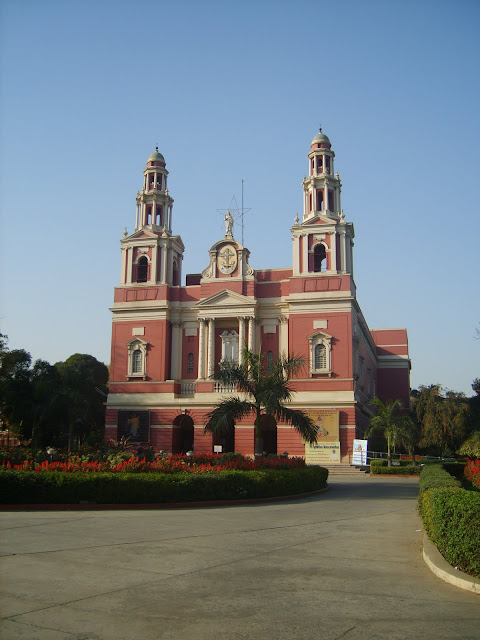Bill Dalton 10th Lancashire Fusiliers
Friday, February 12, 2010
Chindits, the Burma campaign and war memorials
Delhi's layout has been steadily changing over the years. What used to be a huge roundabout at Dhaula Kuan has now changed into a complicated maze of flyovers that takes one to various destinations like Gurgaon, the airport, Delhi's cantonment, R.K. Puram, Motibagh and Naraina, among others. If you manage to find your way out of this maze towards Naraina on Ring Road (or Mahatma Gandhi Road), after about a kilometre there is an U-turn. A traffic junction at this place, known as Gopinath Bazar, has now been replaced by the U-turn to smoothen out traffic movement. If you take the first turn on the left soon after the U-turn you wil reach a railway level crossing. About a kilometre further on is the Delhi War Cemetery, which is a memorial of British soldiers and officers killed in the two World Wars. Next to it is a civilian cemetery of the British as well.
This War Cemetery turned out to be a bit of a surprise for me ... I have lived in and around Delhi for more than three decades. It is one of the cemeteries maintained across the world by the Commonwealth War Graves Commission (earlier known as the Imperial War Graves Commission). This is a body that had among its founders British author Rudyard Kipling (whose son died in the First World War). Kipling was also the originator the the term 'White man's burden' that was the expression of the West's mission to 'civilise' the Orient. But of the cruelty of war he also wrote:
“The flesh we had nursed from the first in all cleanness was given…
To be blanched or gay painted by fumes- to be cindered by fires-
To be senselessly tossed and retossed in stale mutilation
From crater to crater. For this we shall take expiation.
But who shall return us our children?”
Anyway, I visited this cemetery some months back. Outside it some boys play cricket with a tennis ball.. but inside it is calm. The lawns are well maintained. But the heart wrenches when you read the marble gravestones and find that many of the soldiers died at the tender age of 21 or 22 years. The photo that accompanying this post is that of a gravestone on which the name inscribed is 'E.C.S. Dix, Lancashire Fusliers. Right at the top is his service number - 5189477 while his date of death is given as 12th Januray, 1943, aged just 21 years.
Some research on the internet reveals that his full name is Eugene Charles Samuel and that he belonged to the 10th battalion of the Lancashire Fusiliers that saw action in the Burma campaign or what has came to be called the Chindits. I also found an account of parts of the campaign written by William (Bill) Dalton, a lance corporal also of the 10th Battalion. Dalton was wounded in machine gun fire on 9th January, 1943, just three days before Fusilier Dix was killed. I have given the link to Dalton's account. Bill Dalton, by the way, survived the war and died only last year at the age of 93 at his home village of Croston near Chorley in Lancashire (county) in the U.K.
But surely Eugene Dix deserves a little more attention - who was he? why did he join up? who were his parents? does he have any descendents living? Maybe a little more research will bring out the circumstances of his death.
Thursday, February 4, 2010
A correction. Bahadur Shah Zafar's sons were shot dead - not hanged - at Khooni Darwaza by Captain William Hodson who was a young British officer from the Punjab. The Khooni Darwaza, by the way was earlier known as the Kabuli Darwaza and is believed to have been one of the gates of Sher Shah's city of Delhi. It came to be called the Khooni Darwaza from the fact that Bahadur Shah's sons were executed here.
Hodson, it seems, went back with 100 cavalry to Humayun's tomb (near Nizamuddin Auliya's Mazhar) a day after capturing Bahadur Shah Zafar. He had been informed that Zafar's two sons and a grandson - Mirza Mughal, Mirza Khizr Sultan and Mirza Abu Bakr - were hiding there. The three were being taken back to the city when Hodson himself shot the three princes dead.
Hodson wrote to his family: " Today, more fortunate still, I have seized and destroyed the King's two sons and a grandson.... the villians who ordered the massacre of our women and children, and stood by and witnessed the foul barbarity; their bodies are now lying on the spot where those of the unfortunate ladies were exposed. I am very tired but very much satisfied with my day's work."
Hodson, it seems, went back with 100 cavalry to Humayun's tomb (near Nizamuddin Auliya's Mazhar) a day after capturing Bahadur Shah Zafar. He had been informed that Zafar's two sons and a grandson - Mirza Mughal, Mirza Khizr Sultan and Mirza Abu Bakr - were hiding there. The three were being taken back to the city when Hodson himself shot the three princes dead.
Hodson wrote to his family: " Today, more fortunate still, I have seized and destroyed the King's two sons and a grandson.... the villians who ordered the massacre of our women and children, and stood by and witnessed the foul barbarity; their bodies are now lying on the spot where those of the unfortunate ladies were exposed. I am very tired but very much satisfied with my day's work."
Subscribe to:
Posts (Atom)
Church at Gol Dak Khana

serenity amid change
